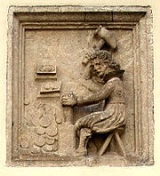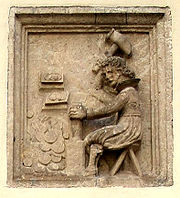
Hammered coinage
Encyclopedia
Hammered coinage is the most common form of coins produced since the invention of coin
s in the first millennium BC until the early modern period of ca. the 15th–17th centuries.
or flan) of the correct weight between two dies, and then striking the upper die with a hammer to produce the required image on both sides. The planchet was usually cast from a mold. The bottom die (sometimes called the anvil die) was usually counter sunk in a log or other sturdy surface and was called a pile. (This may be related to the modern term pile driver
). One of the minters held the die for the other side (called the trussel), in his hand while it was struck either by himself or an assistant.
 In later history, in order to increase the production of coins, hammered coins were sometimes produced from strips of metal of the correct thickness, from which the coins were subsequently cut out. Both methods of producing hammered coins meant that it was difficult to produce coins of a regular diameter. Coins were liable to suffer from "clipping
In later history, in order to increase the production of coins, hammered coins were sometimes produced from strips of metal of the correct thickness, from which the coins were subsequently cut out. Both methods of producing hammered coins meant that it was difficult to produce coins of a regular diameter. Coins were liable to suffer from "clipping
" where unscrupulous people would remove slivers of precious metal since it was difficult to determine the correct diameter of the coin.
Sir Isaac Newton
, after being appointed Master of the Mint
(a charge he held from 1699 to his death), is credited to be the first to have used coins with reeded edge, with fine serrations like a file, to discourage "clipping
".
Coins were also vulnerable to "sweating," which is when silver coins would be placed in a bag that would be vigorously shaken. This would produce silver dust, which could later be removed from the bag.
) caused hammered coins to gradually become obsolete during the 17th century. Interestingly, they were still made in Venice
until the 1770s. France became the first country to adopt a full machine-made coin in 1643.
In England, the first non-hammered coins were produced in the reign of Queen Elizabeth I
in the 1560s, but while machine-produced coins were experimentally produced at intervals over the next century, the production of hammered coins did not finally end until 1662.
, especially in China
, was to cast coins
using molds. This method of coin production continued in China into the nineteenth century. Up to a couple of dozen coins could be produced at one time from a single mold, when a 'tree' of coins (which often contained features such as a square hole in the centre) would be produced and the individual coins (called cash) would then be broken off.
Coin
A coin is a piece of hard material that is standardized in weight, is produced in large quantities in order to facilitate trade, and primarily can be used as a legal tender token for commerce in the designated country, region, or territory....
s in the first millennium BC until the early modern period of ca. the 15th–17th centuries.
History
Hammered coins were produced by placing a blank piece of metal (a planchetPlanchet
A planchet is a round metal disk that is ready to be struck as a coin. An older word for planchet is flan. They are also referred to as blanks.-History:The preparation of the flan or planchet has varied over the years...
or flan) of the correct weight between two dies, and then striking the upper die with a hammer to produce the required image on both sides. The planchet was usually cast from a mold. The bottom die (sometimes called the anvil die) was usually counter sunk in a log or other sturdy surface and was called a pile. (This may be related to the modern term pile driver
Pile driver
A pile driver is a mechanical device used to drive piles into soil to provide foundation support for buildings or other structures. The term is also used in reference to members of the construction crew that work with pile-driving rigs....
). One of the minters held the die for the other side (called the trussel), in his hand while it was struck either by himself or an assistant.

Coin clipping
Coin debasement is the act of decreasing the amount of precious metal in a coin, while continuing to circulate it at face value. This was frequently done by governments in order to inflate the amount of currency in circulation; typically, some of the precious metal was replaced by a cheaper metal...
" where unscrupulous people would remove slivers of precious metal since it was difficult to determine the correct diameter of the coin.
Sir Isaac Newton
Isaac Newton
Sir Isaac Newton PRS was an English physicist, mathematician, astronomer, natural philosopher, alchemist, and theologian, who has been "considered by many to be the greatest and most influential scientist who ever lived."...
, after being appointed Master of the Mint
Master of the Mint
Master of the Mint was an important office in the governments of Scotland and England, and later Great Britain, between the 16th and 19th centuries. The Master was the highest officer in the Royal Mint. Until 1699, appointment was usually for life. Its holder occasionally sat in the cabinet...
(a charge he held from 1699 to his death), is credited to be the first to have used coins with reeded edge, with fine serrations like a file, to discourage "clipping
Coin clipping
Coin debasement is the act of decreasing the amount of precious metal in a coin, while continuing to circulate it at face value. This was frequently done by governments in order to inflate the amount of currency in circulation; typically, some of the precious metal was replaced by a cheaper metal...
".
Coins were also vulnerable to "sweating," which is when silver coins would be placed in a bag that would be vigorously shaken. This would produce silver dust, which could later be removed from the bag.
Milled coins
The ability to fashion coins from machines (Milled coinsMilled coinage
In numismatics, the term milled coinage is used to describe coins which are produced by some form of machine, rather than by manually hammering coin blanks between two dies or casting coins from dies.-History:The earliest machine known for producing coins is the screw press, invented by Leonardo...
) caused hammered coins to gradually become obsolete during the 17th century. Interestingly, they were still made in Venice
Venice
Venice is a city in northern Italy which is renowned for the beauty of its setting, its architecture and its artworks. It is the capital of the Veneto region...
until the 1770s. France became the first country to adopt a full machine-made coin in 1643.
In England, the first non-hammered coins were produced in the reign of Queen Elizabeth I
Elizabeth I of England
Elizabeth I was queen regnant of England and Ireland from 17 November 1558 until her death. Sometimes called The Virgin Queen, Gloriana, or Good Queen Bess, Elizabeth was the fifth and last monarch of the Tudor dynasty...
in the 1560s, but while machine-produced coins were experimentally produced at intervals over the next century, the production of hammered coins did not finally end until 1662.
Cast coins
An alternative method of producing early coins, particularly found in AsiaAsia
Asia is the world's largest and most populous continent, located primarily in the eastern and northern hemispheres. It covers 8.7% of the Earth's total surface area and with approximately 3.879 billion people, it hosts 60% of the world's current human population...
, especially in China
China
Chinese civilization may refer to:* China for more general discussion of the country.* Chinese culture* Greater China, the transnational community of ethnic Chinese.* History of China* Sinosphere, the area historically affected by Chinese culture...
, was to cast coins
Cast coinage
Cast coinage refers to coins made by pouring melted metal into a mold, i.e. casting. It has been used for regular coins, particularly in the Far East, but also on a smaller scale. The method differs from the current mode of coin production, which is done by striking coin blanks that have been cut...
using molds. This method of coin production continued in China into the nineteenth century. Up to a couple of dozen coins could be produced at one time from a single mold, when a 'tree' of coins (which often contained features such as a square hole in the centre) would be produced and the individual coins (called cash) would then be broken off.

